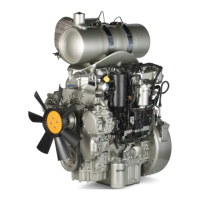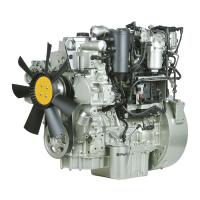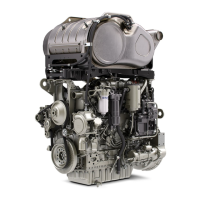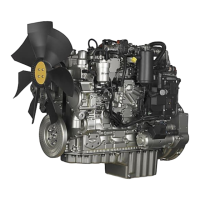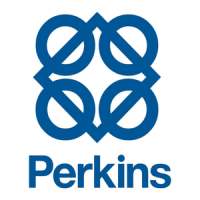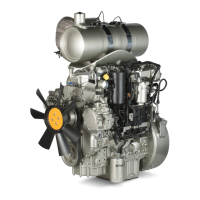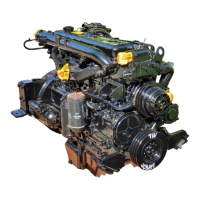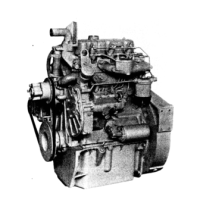Do you have a question about the Perkins 1204F-E44TTA and is the answer not in the manual?
Information regarding California Proposition 65 warnings for engine exhaust and chemicals.
Introduction to basic safety precautions and hazard identification in the manual.
Guidance on understanding and maintaining warning signs on the engine.
Warning about high-pressure fuel hazards, including fluid penetration and fire risks.
Warning regarding the use of ether for starting and potential explosion hazards.
General safety precautions, including personal protective equipment and handling hazards.
Safety precautions when using pressurized air or water for cleaning.
Warnings about touching hot engine parts and preventing burns.
Safety precautions for handling Diesel Exhaust Fluid (DEF), including inhalation and contact hazards.
Guidelines for preventing fires and explosions, including fuel and lubricant handling.
Safety measures to prevent injury from crushing or cutting hazards.
Hazards associated with high-pressure fuel lines, including fluid penetration and fire.
Pre-start checks, including fluid supply, safety tags, and guards.
Safety precautions related to using starting aids and engine starting procedures.
General safety for electrical systems, including battery connections and wiring.
Description of available aftertreatment system types (DOC/SCR, DOC/DPF/SCR).
Details on engine variants (1204F-E44TA/TTA), aftertreatment systems, and general engine characteristics.
Information on locating engine serial number plates and identification labels.
General precautions for lifting and storing the engine and aftertreatment systems.
Information on engine storage, including battery disconnection and DEF system purging.
Explanation of engine shutoff conditions and alarm indicators.
How the SCR system reduces NOx emissions using DEF and potential overheating issues.
Table detailing performance settings for Category 1 faults (Tampering, Dosing Interruption/Quality).
Description of low DEF level warning lamp operation and system behavior.
Function of the battery disconnect switch and procedures for DEF system cooling/purging.
Information on engine gauges and indicators, and how to interpret them.
Overview of the monitoring system for engine and aftertreatment indicators.
Table detailing the meaning of different warning lamp states and engine status.
Typical locations of sensors and electrical components on the engine and aftertreatment system.
Engine's self-diagnostic capability, how diagnostic codes are stored and retrieved.
Parameters programmed at the factory that affect engine emissions and power.
Required daily and periodic maintenance checks before starting the engine.
Step-by-step instructions for starting the engine, including glow plug operation.
Key factors for obtaining maximum engine life and economy through proper operation.
Factors affecting engine operation in cold weather, including fuel and battery.
Reasons Perkins discourages airflow restriction devices in front of radiators.
How diesel fuel properties significantly affect engine cold start capability.
Procedures for stopping the engine to prevent overheating and wear.
Approximate refill capacities for engine crankcase oil and cooling systems.
Information on DEF tank capacities and quality requirements.
How DEF is injected into the SCR system to reduce NOx emissions.
Importance of coolant maintenance, types of coolant components, and potential failures.
Importance of following lubricant recommendations for emission certification compliance.
Perkins' recommendation for using Perkins Diesel Engine Oil and its benefits.
Procedures for releasing pressure from the coolant, fuel, and lubricating systems.
Safety warnings and procedures for servicing high-pressure fuel lines.
Definition of severe service and factors affecting component wear and maintenance intervals.
Schedule of maintenance tasks based on service hours or time intervals.
Procedure for cleaning and testing the air-to-air aftercooler.
Inspection of belts for wear, cracks, and contamination; conditions for replacement.
Inspection of Clean Emissions Module (CEM) mounts for wear or damage.
Procedure for cleaning or replacing the DEF tank filler screen.
Procedure for replacing the DEF manifold filter.
Procedure for cleaning or replacing the DEF filter assembly.
Procedure for flushing the DEF tank, including filter replacement and refilling.
Importance of keeping the engine clean for leak detection, heat transfer, and maintenance ease.
Safety warnings regarding hot oil and the procedure for checking engine oil level.
Procedure for obtaining engine oil samples for analysis and related information to record.
Commissioning information for setting fan tip clearance with the radiator empty.
Procedure for replacing the in-line fuel filter, including fuel supply valve and priming.
Safety warnings and procedure for draining and replacing the primary fuel filter/water separator element.
Safety warnings and procedure for draining the primary fuel filter/water separator.
Importance of draining water and sediment from fuel tanks for engine performance.
Recommended inspection of the starting motor for correct operation and electrical connections.
General procedure for performing a walk-around inspection of the engine.
Safety warnings and inspection procedures for high-pressure fuel lines.
How a failed water pump can cause overheating and potential engine damage.
Details of the emissions warranty for non-road diesel engines and aftertreatment systems.
Warrants that engines conform to emission standards and are free from defects.
Benefits of purchasing an Extended Service Contract for protection against unexpected repair costs.
Information regarding California Proposition 65 warnings for engine exhaust and chemicals.
Introduction to basic safety precautions and hazard identification in the manual.
Guidance on understanding and maintaining warning signs on the engine.
Warning about high-pressure fuel hazards, including fluid penetration and fire risks.
Warning regarding the use of ether for starting and potential explosion hazards.
General safety precautions, including personal protective equipment and handling hazards.
Safety precautions when using pressurized air or water for cleaning.
Warnings about touching hot engine parts and preventing burns.
Safety precautions for handling Diesel Exhaust Fluid (DEF), including inhalation and contact hazards.
Guidelines for preventing fires and explosions, including fuel and lubricant handling.
Safety measures to prevent injury from crushing or cutting hazards.
Hazards associated with high-pressure fuel lines, including fluid penetration and fire.
Pre-start checks, including fluid supply, safety tags, and guards.
Safety precautions related to using starting aids and engine starting procedures.
General safety for electrical systems, including battery connections and wiring.
Description of available aftertreatment system types (DOC/SCR, DOC/DPF/SCR).
Details on engine variants (1204F-E44TA/TTA), aftertreatment systems, and general engine characteristics.
Information on locating engine serial number plates and identification labels.
General precautions for lifting and storing the engine and aftertreatment systems.
Information on engine storage, including battery disconnection and DEF system purging.
Explanation of engine shutoff conditions and alarm indicators.
How the SCR system reduces NOx emissions using DEF and potential overheating issues.
Table detailing performance settings for Category 1 faults (Tampering, Dosing Interruption/Quality).
Description of low DEF level warning lamp operation and system behavior.
Function of the battery disconnect switch and procedures for DEF system cooling/purging.
Information on engine gauges and indicators, and how to interpret them.
Overview of the monitoring system for engine and aftertreatment indicators.
Table detailing the meaning of different warning lamp states and engine status.
Typical locations of sensors and electrical components on the engine and aftertreatment system.
Engine's self-diagnostic capability, how diagnostic codes are stored and retrieved.
Parameters programmed at the factory that affect engine emissions and power.
Required daily and periodic maintenance checks before starting the engine.
Step-by-step instructions for starting the engine, including glow plug operation.
Key factors for obtaining maximum engine life and economy through proper operation.
Factors affecting engine operation in cold weather, including fuel and battery.
Reasons Perkins discourages airflow restriction devices in front of radiators.
How diesel fuel properties significantly affect engine cold start capability.
Procedures for stopping the engine to prevent overheating and wear.
Approximate refill capacities for engine crankcase oil and cooling systems.
Information on DEF tank capacities and quality requirements.
How DEF is injected into the SCR system to reduce NOx emissions.
Importance of coolant maintenance, types of coolant components, and potential failures.
Importance of following lubricant recommendations for emission certification compliance.
Perkins' recommendation for using Perkins Diesel Engine Oil and its benefits.
Procedures for releasing pressure from the coolant, fuel, and lubricating systems.
Safety warnings and procedures for servicing high-pressure fuel lines.
Definition of severe service and factors affecting component wear and maintenance intervals.
Schedule of maintenance tasks based on service hours or time intervals.
Procedure for cleaning and testing the air-to-air aftercooler.
Inspection of belts for wear, cracks, and contamination; conditions for replacement.
Inspection of Clean Emissions Module (CEM) mounts for wear or damage.
Procedure for cleaning or replacing the DEF tank filler screen.
Procedure for replacing the DEF manifold filter.
Procedure for cleaning or replacing the DEF filter assembly.
Procedure for flushing the DEF tank, including filter replacement and refilling.
Importance of keeping the engine clean for leak detection, heat transfer, and maintenance ease.
Safety warnings regarding hot oil and the procedure for checking engine oil level.
Procedure for obtaining engine oil samples for analysis and related information to record.
Commissioning information for setting fan tip clearance with the radiator empty.
Procedure for replacing the in-line fuel filter, including fuel supply valve and priming.
Safety warnings and procedure for draining and replacing the primary fuel filter/water separator element.
Safety warnings and procedure for draining the primary fuel filter/water separator.
Importance of draining water and sediment from fuel tanks for engine performance.
Recommended inspection of the starting motor for correct operation and electrical connections.
General procedure for performing a walk-around inspection of the engine.
Safety warnings and inspection procedures for high-pressure fuel lines.
How a failed water pump can cause overheating and potential engine damage.
Details of the emissions warranty for non-road diesel engines and aftertreatment systems.
Warrants that engines conform to emission standards and are free from defects.
Benefits of purchasing an Extended Service Contract for protection against unexpected repair costs.
| Engine Model | 1204F-E44TTA |
|---|---|
| Fuel System | Common Rail |
| Displacement | 4.4 L |
| Aspiration | Turbocharged |
| Emission Standards | US EPA Tier 4 Final, EU Stage IV |
| Cooling System | Liquid-cooled |
